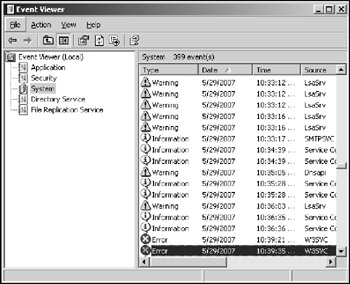Look at Event Logs
One of the most useful troubleshooting techniques for diagnosing network problems is to review the network operating system's built-in event logs. These logs contain information about interesting and potentially troublesome events that occur during the daily operation of your network. Ordinarily, these logs run in the background and quietly gather information about network events. When something goes wrong, you can check the logs to see whether the problem generated a noteworthy event. In many cases, the event logs contain an entry that pinpoints the exact cause of the problem and suggests a solution.
To display the event logs in a Windows server, use the Event Viewer, available from the Administrative Tools menu. For example, Figure 19-3 shows the Event Viewer from a Windows Server 2003 system. The tree listing on the left side of the Event Viewer lists five categories of events that are tracked:
-
Application events
-
Security events
-
System events
-
Directory Service events
-
File Replication Service events

Figure 19-3: Event logs keep track of interesting and potentially troublesome events.
Select one of these options to see the log that you want to view. For details about a particular event, double-click the event; this action displays a dialog box that lists detailed information about the event.